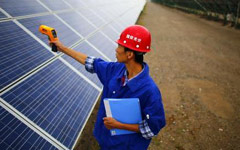Building-integrated systems slash energy consumption, but cost a lot
China's market for building-integrated photovoltaic energy offers huge potential for solar power companies, builders and governments to cut carbon emissions, experts said.
The country aims to have 1.79 billion square meters for BIPV buildings in the next five years, which means a carbon reduction of 52 million metric tons if those areas are equipped with solar panels for power generation, said Liu Min, executive president of Hanergy Holding Group, the world's largest thin-film photovoltaic solar panel manufacturer.
"The market has a growing need for BIPV projects and China is still at the initial stage," he said.
 |
| Top 10 richest individuals in China |
 |
| Cooperation, not conflict on solar energy |
According to the European Photovoltaic Industry Association, BIPV buildings account for more than 80 percent of solar power generation in Europe.
Although China is the world's largest solar panel producer, more than 95 percent of the sector's output is exported.
Strictly speaking, the actual production of solar panels is not "clean energy", even though the electricity generated by solar facilities is, said Li Junfeng, director of the National Center for Climate Change Strategy and International Cooperation.
"China should make more efforts to use clean energy such as solar and wind," Li said.
In China, more than 95 percent of existing buildings are energy-intensive structures, according to the Ministry of Housing and Urban-Rural Development.
Energy use in the building construction sector accounts for 27 percent of China's total energy consumption. In the past year, the construction sector consumed energy equal to 1 billion metric tons of standard coal, said the ministry.
In late October, Hanergy announced that the first phase of the BIPV project at its headquarters in Beijing was complete. The company installed 600 kilowatts of solar power generation capacity in the roofs and curtain walls, and those facilities can supply 20 percent of the building's electricity, according to Hanergy.
The company will be able to derive 100 percent of its power supply via BIPV projects after the completion of the second phase.
The project will generate 3 million kilowatt-hours of electricity annually and reduce carbon emissions by 25 million tons, said the company.
Roofs have been the traditional area for solar panel installations because of their wide area and good sunshine conditions. Roofs are perfect for polysilicon solar modules, which are shaped like hard plastic plates. But thin-film solar panels, which are flexible, have made more building areas suitable for solar power panel installations.
In Beijing's Huairou district, the site of the 2014 Asia-Pacific Economic Cooperation meeting, Hanergy completed a 12.2 kW BIPV project in March.
However, BIPV projects have a downside - high costs. The unit cost of such installations is 800 yuan ($131) to 1,200 yuan per square meter. Liu said the payback period for such projects is eight to 12 years.
Industry sources said the high costs and long payback periods make it difficult to attract users.
